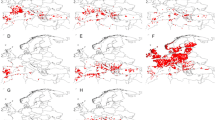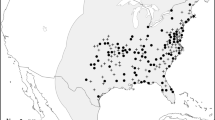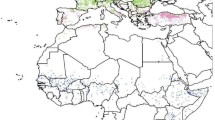Abstract
Climate matching models are in increasing use to predict distributions of living organisms, using records of the known distribution of a species to map its expected range of habitat suitability. Here, we modelled the known distribution of the tick Amblyomma variegatum in Africa as a preliminary step to delineate the most probable range of climatically suitable habitat for the tick in the New World. We used two presence-only methods (one based in the Gower distance, the other based on the Maximum Entropy principle) to model the distribution range in Africa. The Maximum Entropy method is highly dependent of the realized niche of the tick, and has serious constraints in the case of lack of adequate description of the actual range of the tick. The Gower distance, however, can evaluate the fundamental niche of the tick and produced better results with the same set of distribution data. Several populations of A. variegatum were recognized in Africa on the basis of statistically different ecological attributes. The separate modelling of the climate envelope for these populations provided a better fit in the delineation of habitat suitability with both methods in Africa but produced high rates of false negatives when applied to the Caribbean. The best modelling strategy for the tick in the New World (according to the rate of false negatives) is the use of Gower distance together with the known distribution of the tick in the Caribbean. The potential spread area of the tick includes all the Caribbean, large areas of Colombia and Venezuela, parts of Brazil, most of the Mesoamerican corridor and Mexico as well as the Peninsula of Florida. We do not consider further if the invading strain either still retains the full ecological plasticity of the original populations in Africa, or has already adapted to the invaded area, resulting in a more restricted ability to expand. Both possibilities have deep impact in our analyses, as the tick could find a larger zone for spreading into the New World.





Similar content being viewed by others
References
Araújo MB, Humphries CJ, Densham PJ, Lampinen R, Hagemeijer WJM, Mitchell-Jones AJ, Gasc JP (2001) Would environmental diversity be a good surrogate for species diversity? Ecography 24:103–110
Barré N, Garris G, Camus E (1995) Propagation of the tick Amblyomma variegatum in the Caribbean. Rev Sci Tech 14:841–855
Barré N, Uilenberg G, Morel P-C, Camus E (1987) Danger of introducing Heartwater onto the American mainland: potential role of indigenous and exotic Amblyomma ticks. Onderstepoort J Vet Res 54:405–417
Burridge MJ, Simmons LA, Peter TF, Mahan SM (2002) Increasing risks of introduction of Heartwater onto the American mainland associated with animal movements. Ann NY Acad Sci 969:269–274
Corn JL, Barre N, Thiebot B, Creekmore TE, Garris GI, Nettles VF (1993) Potential role of cattle egrets, Bubulcus ibis (Ciconiformes: Ardeidae), in the dissemination of Amblyomma variegatum (Acari: Ixodidae) in the eastern Caribbean. J Med Entomol 30:1029–1037
Davis MB, Shaw RG (2001) Range shifts and adaptive responses to quaternary climate change. Science 292:673–679
Engler R, Guisan A, Rechsteiner L (2004) An improved approach for predicting the distribution of rare and endangered species from occurrence and psuedo-absence data. J Appl Ecol 41:2632–2674
Estrada-Peña A, Venzal JM, Sánchez Acedo C (2006) The tick Ixodes ricinus: distribution and climate preferences in the western Palaearctic. Med Vet Entomol 20:189–197
Fielding AH, Bell JF (1997) A review of methods for the assessment of prediction erros in conservation presence/absence models. Environ Conserv 24:38–49
Gower JC (1971) General coefficient of similarity and some of its properties. Biometrics 27:857–874
Guisan A, Zimmerman NE (2000) Predictive habitat distribution models in ecology. Ecol Model 135:147–186
Hierro JL, Maron JL, Callaway RM (2005) A biogeographical approach to plan invasions: the importance of studying exotics in their introduced and native range. J Ecol 93:5–15
International Consortium of Ticks and Tick-Borne Diseases (ICTTD) (2004) Ticks of veterinary and medical importance. A series of three CD’s on ticks of livestock in Africa, The Mediterranean region and Latin America (http://www.icttd.nl)
Kriticos DJ, Randall RP (2001) A comparison of systems to analyze potential weed distributions. In: Grooves RH, Panetta FD, Virtue JG (eds) Weed risk assessment. CSIRO Publishing, Collingwood, Victoria, Australia, pp 61–79
Lobo JM, Verdú JR, Numa C (2006) Environmental and geographical factors affecting the Iberian distribution of flightless Jekelius species (Coleoptera: Geotrupidae). Divers Distrib 12:179–188
Loehle C, LeBlanc D (1996) Model-based assessments of climate change effects on forests: a critical review. Ecol Modell 90:1–31
Mau-Crimmins TM, Schussman HR, Geiger EL (2006) Can the invaded range of a species be predicted sufficiently using only native-range data? Lehmann lovegrass (Eragrostis lehmanniana) in the southwestern United States. Ecol Modell 193:736–746
Pearce J, Ferrier S (2000) Evaluating the predictive performance of habitat models developed using logistic regression. Ecol Modell 133:225–245
Petney TN, Horak IG, Rechav Y (1987) The ecology of the African vectors of Heartwater, with particular references to Amblyomma hebraeum and Amblyomma variegatum. Ondertspoort J Vet Res 54:381–395
Phillips SJ, Anderson RP, Schapire RE (2006) Maximum entropy modelling of species geographic distribution. Ecol Modell 190:231–259
Sutherst RW, Maywald GF (1985) A computerised system for matching climates in ecology. Agric Ecosyst Environ 13:281–299
Swets KA (1988) Measuring the accuracy of diagnostic systems. Science 240:1285–1293
Titeux N (2006) Modelling species distribution when habitat occupancy departs from suitability. Application to birds in a landscape context. PhD Thesis, University of Louvain (Belgium), pp 243
Tonnesen MH, Penzhorn BL, bryson NR, Stoltsz WH, Masiwigiri T (2004) Displacement of Boophilus decoloratus by Boophilus microplus in the Soutpansbeg region, Limpopo province, South Africa. Exp Appl Acarol 32:199–208
Walker JB, Olwage A (1987) The tick vectors of Cowdria ruminantium (Ixodoidea, Ixodidae, genus Amblyomma) and their distribution. Onderstepoort J Vet Res 54:353–379
Wang J, Rich PM, Price KP (2004) Temporal responses of NDVI to precipitation and temperature in the central Great Plains, USA. Int J Remote Sens 24:2345–2364
Walker AR, Bouattour A, Camicas J-L, Estrada-Peña A, Horak I, Latif AA, Pegram RG, Presto PM (2004) Ticks of domestic animals in Africa. A guide of identification of species. Bioscience Reports, Edinburgh, UK, 221 pp
Welk E (2004) Constraints in range prediction of invasive plant-species due to non-equilibrium distribution patterns: purple loosestrife (Lythrum salicaria) in North America. Ecol Modell 179:551–567
Zaniewski AE, Lehmann A, Overton JM (2002) Predicting species spatial distributions using presence-onlu data: a case study of native New Zealand ferns. Ecol Modell 157:261–280
Acknowledgements
The authors wish to acknowledge the help of Gerrit Uilenberg in reading previous versions of this manuscript and for providing data from Central African Republic and Tchad. Alberto Guglielmone and Trevor Peter provided data about the distribution of the tick in the Caribbean and Zimbabwe, respectively. Special thanks are due to Willfied Thuiller by the S-plus function.
This work has been facilitated by the The Integrated Consortium on Ticks and Tick-borne Diseases (ICTTD-3), financed by the International Cooperation Program of the European Union through Coordination Action Project No. 510561.
Author information
Authors and Affiliations
Corresponding author
Rights and permissions
About this article
Cite this article
Estrada-Peña, A., Pegram, R.G., Barré, N. et al. Using invaded range data to model the climate suitability for Amblyomma variegatum (Acari: Ixodidae) in the New World. Exp Appl Acarol 41, 203–214 (2007). https://doi.org/10.1007/s10493-007-9050-9
Received:
Accepted:
Published:
Issue Date:
DOI: https://doi.org/10.1007/s10493-007-9050-9




